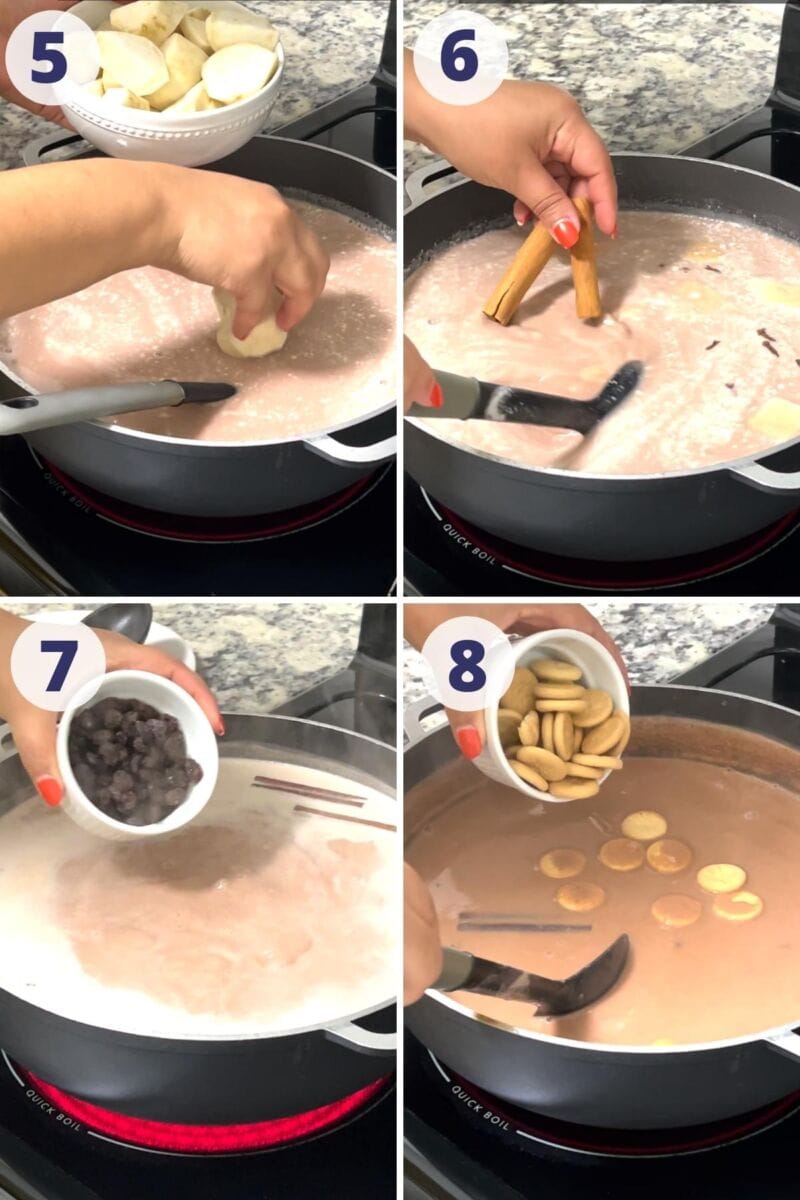Nothing says Cuaresma in a Dominican household quite like a warm pot of Habichuelas con Dulce simmering on the stove. I grew up watching my family make this beloved dessert every year, and now, it’s one of my favorite traditions to share. That first creamy, spiced spoonful instantly brings back memories of childhood.
Anyone who enjoys Jalea aka Dulce de Batata aka Dominican Sweet Potato Pudding or Quesillo aka Flan de Coco (Coconut Flan) will appreciate the rich, comforting flavors of this Dominican Habichuelas con Dulce recipe. This is more than just a dessert—it’s a taste of home, a celebration of tradition, and the perfect way to bring loved ones together.

What is Habichuelas Con Dulce?
Habichuelas con dulce (sweet beans) is a popular Dominican dessert made most often during Easter, Holy Week, or Lent. Dominican sweet beans are usually made in very large quantities and shared among relatives and friends. I’ve seen people make enough of this dessert to feed entire neighborhoods—and they usually do share it with everyone around them!
I grew up watching my grandmother, my mother, and my aunts make this dessert every year. When I moved to New York and lived with my mom, I was surprised at how she would still make this dessert during Lent just for the two of us. She always made a little extra to bring to her coworkers, keeping our traditions alive even in a foreign country.
Many Dominican restaurants around New York City sell this delicious dessert warm in small foam coffee cups. I’ve seen people take early breaks from work just to get their hands on one of those cups before they run out!
How to Make Habichuelas con Dulce
Making Habichuelas con Dulce at home is easier than you think—just follow these simple steps:
Prepare the Beans – Soak the beans overnight, then drain and boil them in fresh water until soft. This step takes time, but it’s what gives this dessert its signature creamy texture.

Blend & Strain – Once the beans are tender, blend them with some of the cooking water until smooth. Strain the mixture into a large bowl, or directly into the pot you’ll cook them in, to remove any remaining skins or bits.
Simmer with Spices & Milk – In a large pot, combine the strained beans with coconut milk and evaporated milk. Bring to a gentle boil, then stir in salt, sugar, batata, ginger, vanilla, cinnamon sticks, cloves, and raisins.

Cook Until Thick & Creamy – Let everything simmer for about 45–50 minutes, stirring occasionally, until the liquid thickens slightly and the sweet potatoes are tender. The longer it simmers, the creamier it gets!
Cool & Serve – Remove from heat and let it cool slightly before serving. Enjoy warm or chilled, topped with small milk crackers for the perfect finishing touch.

Serving Suggestions
Habichuelas con dulce is traditionally served with small round milk crackers or toasted casabe (cassava bread) for added crunch.
Storage Tips
Refrigerate: Store in an airtight container in the fridge for up to 3 days. Keep in mind that it thickens as it cools!
Freeze: You can freeze habichuelas con dulce but not as a way to store it, but rather if you plan on eating it that way. You can turn habichuelas con dulce to your liking and make it an habichuelas con dulce ice cream, a frozen popsicle, or even gelato.
Recipe Tips
- I personally like to use Dominican red beans because it most closely resembles the habichuelas con dulce my grandmother made, but you can use regular red beans or Pinto beans for this recipe.
- Once the sweet beans are chilled, they become a lot thicker. Keep that in mind when letting it reduce while cooking.

Creamy Dominican Habichuelas con Dulce Recipe
Author:Ingredients
- 4 cups red or pinto beans
- 7 cups water in which the beans had boiled in
- 1 can (13.5 ounces) coconut milk
- 2 cans (24 ounces) evaporated milk
- 1/2 teaspoon salt
- 1 1/2 cups sugar
- 1 pound batata, cubed
- 1 tablespoon fresh ginger, peeled and cut in one piece
- 1 teaspoon vanilla extract
- 2 cinnamon sticks
- 10 whole cloves
- 1/2 cup raisins
- 2 packs (6 ounces) small milk round crackers
Instructions
- Soak dry beans in water overnight. The next day discard water in beans. Boil the beans in a large pot with plenty of water, adding water as needed, for about 2 hours, or until tender.
- Blend together beans and water for about 30 seconds, or until smooth. If necessary, add more water. Pass the mixture through a strainer into a large bowl and set aside.
- Combine the beans, the coconut milk, and the evaporated milk in a large pot over medium heat.
- When it breaks a boil, stir in the salt, sugar, sweet potatoes, ginger, vanilla, cinnamon sticks, clove, and raisins.
- Let simmer, stirring occasionally, for about 45-50 minutes, or until the liquid reduces to desired thickness and the sweet potato is tender. Remove from the heat and let cool.
- Serve warm or cold, add crackers when ready to eat. If eating cold, place it in the refrigerator after cooling until it is cold.
Video
Notes
- I personally like to use Dominican red beans because it most closely resembles the habichuelas con dulce my grandmother made, but you can use regular red beans or Pinto beans for this recipe.
- This dessert can be enjoyed warm or cold.
- Once the sweet beans are chilled, they become a lot thicker. Keep that in mind when letting it reduce while cooking.
Nutrition
The nutritional information of this recipe and all recipes on mydominicankitchen.com is only an estimate. The accuracy of any recipe on this site is not guaranteed.









Nicole says
Is it bad if I didn’t replace the water that the beans soaked in overnight? I forgot and just moved the pot to the stove to boil :/
Vanessa says
It’s not bad, although, I always prefer to replace the water with fresh water.
Enriqueta E Lemoine says
This is so Dominicano! I have to give them a try!
Silvia says
Great recipe, very comforting and easy to make.
Ale says
This recipe is amazing, never tried habichuelas, excited to try them.
Kate says
I think this sounds so good. It’s kind of like the Japanese sweet Adzuki bean dessert that I just love. The only ingredient I’m unsure of is Batata. What is it?
Vanessa says
Hi Kate, Batata is sweet potato. We use the Caribbean sweet potato for this dessert, which is the one that is white with purple skin. It’s a really delicious dessert. Give it a try. 🙂
Enriqueta E Lemoine says
I never tried this befores but I know this is a must when talking about Domininican cuisine! Thanks for sharing Vane…
Vanessa says
It’s so good Enri! You must try it one day.
Chupacabra says
Habichuelas con dulce is one of those desserts that you either love or hate mainly because it can be too rich and filling. I must admit that I am not a huge fan of it, however, I did tweak my recipe several times until I came up with one that I can eat a over and over again, enjoy it and not feel like need to drink 2 glasses of water to wash it down after. The sweet beans are creamy, smooth and decadent!
wendy browne says
Wow, it sounds and looks so much like the bean paste desserts my kids love in the Asian markets. I have such Americanized taste buds, if you told me what it was I would probably only taste “chili beans”. If you just asked me to try it, I would probably like it. Where did the tiny cross crackers come from? Those are neat. I also grew up Catholic and my mom would have NEVER let us eat the cross. >.<
Vanessa says
Hi Wendy, I know a beans dessert can sound very weird. But, I promise it’s delicious and tastes nothing like chili beans. The cross crackers I get from my local grocery store in the Hispanics food aisle. Some grocery stores don’t carry them , but if you find a grocery store with a predominantly Hispanic customer base, they will most likely sell them. I grew up Catholic as well, but my family never had an issue with this crackers. My grandmother actually preferred them over other crackers. Thanks for reading! 🙂
Alicia says
No soy muy amante lol I like having a lil taste y ya. I think I ate them too much growing up. But your recepie seems somaimple that I may surprise my mom
Next year and make a batch for her or even make a batch for church. Thanks for sharing!
Maria Diaz says
Yummm!!!!!! looks sooo good!! I think this good Friday i will deff try to make it… Soooo good!!!
yliana says
one of my task on my spring break ill let you know how it went